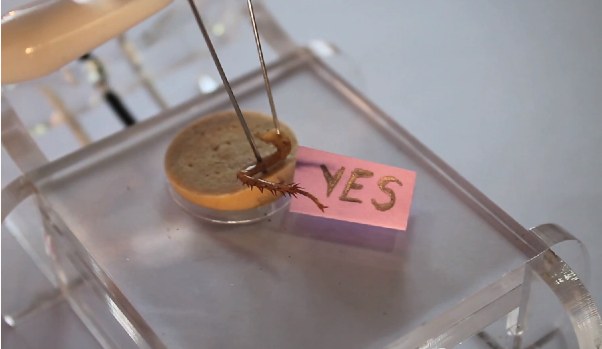Human Brainwaves Move a Cockroach Leg
A community science group in Chile called Thinker Thing has used an EEG headset to move the leg of a cockroach. Among the mood-reading headbands and brain-controlled helicopters we’ve encountered in this blog, EEG-controlled roach legs are up there among the wilder uses we’ve seen for this emerging brain-to-world technology.

Reuters visited Thinker Thing and interviewed Bryan Salt, the founder of the group, who described the setup. He used an EEG reader made by Emotiv to capture electrical signals from his brain. A software converted them into waveforms, certain frequencies of which were turned into electrical signals that got the roach leg kicking.
This makes sense when you consider that muscles—yours, mine, and those of the cockroach—are controlled by tiny bursts of current supplied by nerves, guided by electrical directions from our brains.
An amputated lone leg of a roach can be enervated by any electrical ping, if it’s at the right frequency, which is why the leg does a jig on a corkboard, separate from the anesthetized roach to which it belonged.
Thinker Thing is also building software that observes and “learns” which kinds of electrical signals are related to what kinds of motion in the leg, to be able to better control the induced movement. Thinker Thing tried out the moving roach setup at Hack Day in late October.
Backyard Brains, an educational group from California, has one of the more memorable demonstrations of the relationship between waveforms, electrical signals and disembodied roach legs. In a TedEd video (below) they pin electrodes onto a amputated roach leg to first listen in on electrical chitchat between neurons.
Then, reversing the direction of electrical signal sending, they cause the leg to twitch to the beat of song played on an iPhone.
For folks inspired to recreate the roach disco at home, Thinker Thing and Backyard Brains have created a device called SaltShaker which pipes in impulses derived from musical waveforms into the roach legs, while a camera records the twitches that result.
Keep Reading
Most Popular
Large language models can do jaw-dropping things. But nobody knows exactly why.
And that's a problem. Figuring it out is one of the biggest scientific puzzles of our time and a crucial step towards controlling more powerful future models.
The problem with plug-in hybrids? Their drivers.
Plug-in hybrids are often sold as a transition to EVs, but new data from Europe shows we’re still underestimating the emissions they produce.
Google DeepMind’s new generative model makes Super Mario–like games from scratch
Genie learns how to control games by watching hours and hours of video. It could help train next-gen robots too.
How scientists traced a mysterious covid case back to six toilets
When wastewater surveillance turns into a hunt for a single infected individual, the ethics get tricky.
Stay connected
Get the latest updates from
MIT Technology Review
Discover special offers, top stories, upcoming events, and more.